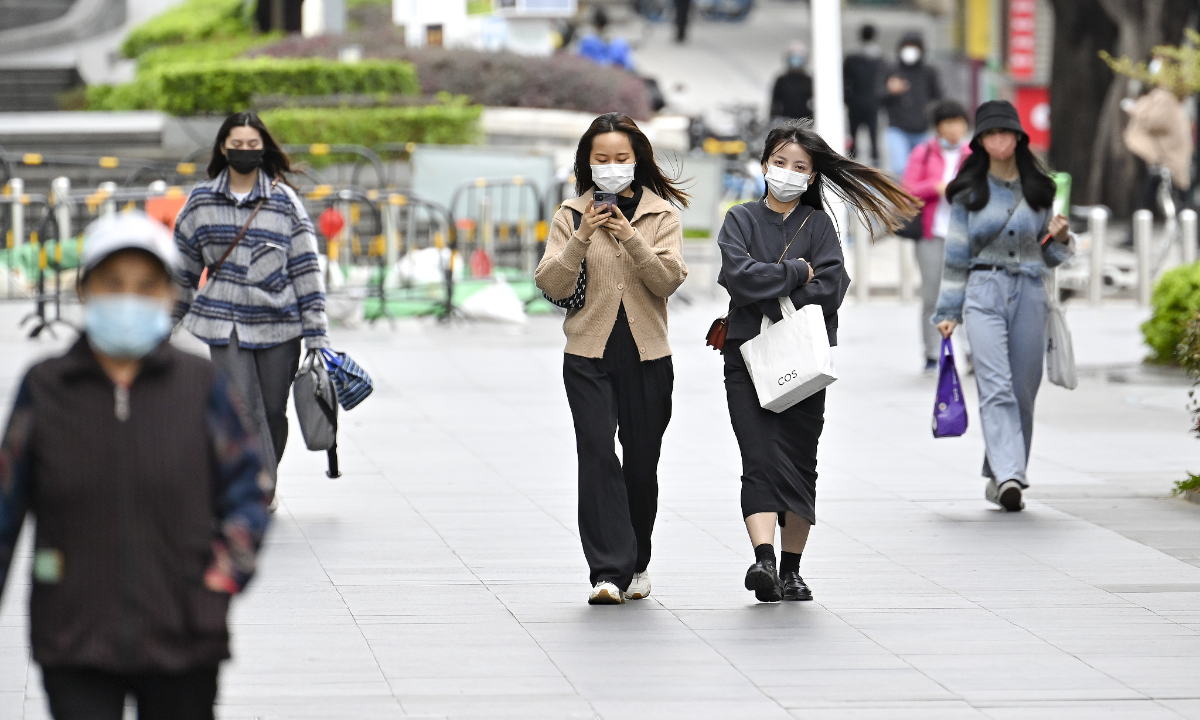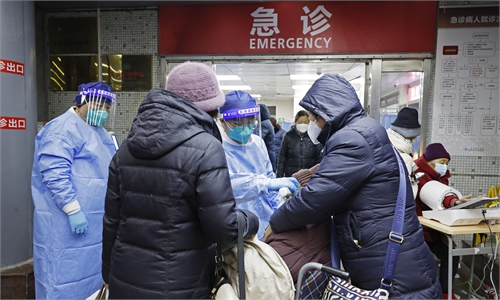China’s three-year anti-COVID efforts not in vain

Residents wearing face masks on a street in Guangzhou in South China’s Guangdong Province on Thursday. Several districts in Guangzhou have lifted temporary restrictions. Photo: VCG
The focus of China’s COVID-19 epidemic prevention has shifted from infection prevention to health preservation and prevention of severe cases. China has undoubtedly done the best job in the world in preventing infections in the early stage and severe cases at this stage. The next few weeks will be critical in the battle for safeguarding lives. It is believed that hospitals across China will exert all their efforts with the government’s strong support.
The basic judgment is that even in the worst-case scenario, the COVID-19 mortality rate in China should be much lower than that of the US and Europe in the last three years if the same statistical criteria are applied. Everyone can remain completely confident about this.
According to data from Johns Hopkins University (JHU), the total number of COVID-19 cases in the US to date exceeds 100.38 million, while COVID-19 deaths in the country reached 1.09 million. These numbers are obviously skewed, but reflect the proportional and structural relations of COVID-19 deaths. A recent analysis from researchers from schools of public health at Harvard, Yale, and Stanford found that an estimated 94 percent of people in the US had been infected with the novel coronavirus at least once. Based on such a percentage, the actual number of US COVID-19 cases is three times higher than that from the JHU. We can all imagine that China’s epidemic will peak if the same percentage occurs in China in the worst-case scenario and after a long enough period.
Most of the COVID-19 deaths in the US in the last three years have been caused by the original strain and the Delta variant. Data from the JHU showed that by the end of 2021, the US had 54.5 million cumulative cases and 820,000 deaths, representing, respectively, about half and 75 percent of the country’s total cases and deaths so far.
The Omicron variant was discovered last November. In JHU’s incomplete data, the number of Omicron cases in 2022 is equal to the sum of the total COVID-19 infections in 2020 and 2021 combined. However, the variant caused only one-third of the deaths of the previous two years. In other words, the death rate from Omicron is significantly lower even with the same amount of infections. And it will continue to weaken after 2022, according to the basic understanding of Omicron in the scientific community so far.
China’s three-year COVID-19 prevention and control has helped the vast majority of Chinese people to stay away from the original strain and Delta variant. As a result, although China today is experiencing a rapid increase in COVID-19 transmission and some hospitals in the country are treating the greatest-ever number of severe cases, it is certain that the actual mortality rate and the number of deaths have been greatly reduced.
Because even if about 94 percent of the Chinese people are infected with the novel coronavirus in the worst-case scenario and after a long enough period of time, all of them will be infected with Omicron. This is destined to bring on very different results than if half of them were infected with the original strain or Delta variant.
Apart from the fact that the COVID-19 variant is growing milder, we now have the protection of the vaccine, the support of some antiviral drugs against COVID-19 and the accumulation of a great deal of experience in treatment. All these will help the fight against Omicron and help us reduce the mortality rate and the death toll.
It is important to see that although the wave of COVID-19 infections has hit China hard, the situation across the country is rapidly stabilizing. China has a very strong power of overall mobilization to deal with a prominent problem. Since reducing severe cases and deaths has become a primary national goal, there will be a lot of room for action and initiative.
It was reported on Thursday that China’s daily output of ibuprofen and acetaminophen – two antipyretic analgesics – is now four times higher than at the beginning of December, reaching 190 million tablets. It can be expected that the shortage of essential medicines will be solved soon as many cities have already started to distribute a certain amount of ibuprofen to the elderly for free.
China’s three-year epidemic prevention and control was by no means “in vain.” Its protection of the people stands like a giant dam that bigger waves can overtop but never crash it.
The author is a commentator with the Global Times. opinion@globaltimes.com.cn



